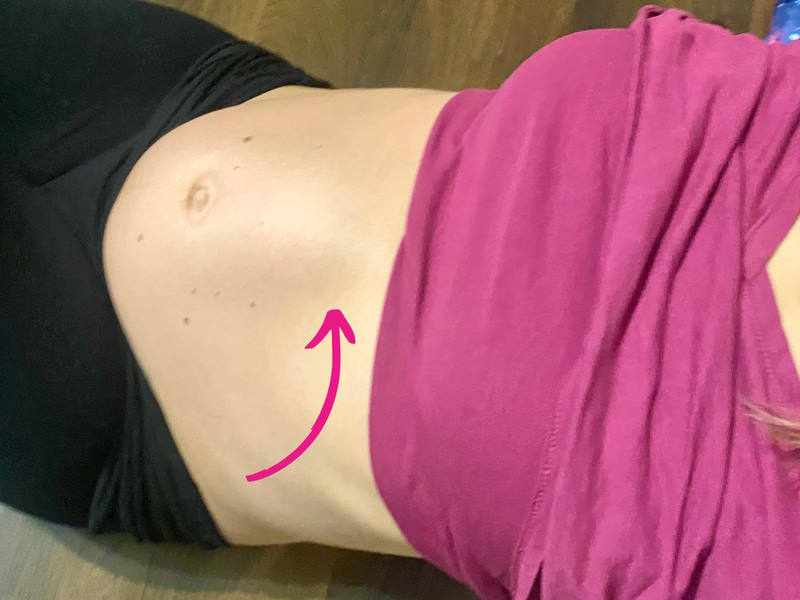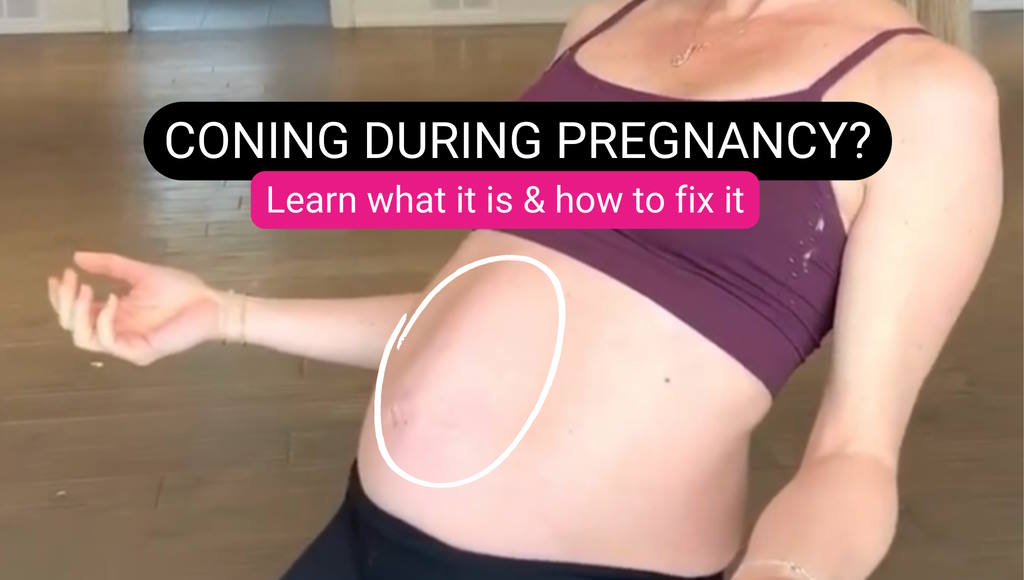Have you ever looked down at your pregnant belly during exercise and thought, “What the heck is this ridge popping out of my tummy?” Coning in pregnancy is really common.
Though it’s common, it is important to minimize coning to protect your core muscles.
What Is Coning In Pregnancy?
Coning in pregnancy happens when the connective tissue between your six pack thins and widens. This is called diastasis recti. Nearly all women experience diastasis recti during pregnancy. Your body does this to make room for the growing baby!
Because that once taut tissue is now stretched, your insides push on the tissue, causing a bulge.
What Does Coning Look Like In Pregnancy?
When you experience coning in pregnancy, you may notice that your midline appears to have a ridge, tent or even football shape. You might notice it all the way down your tummy, or more prominently at the belly button.
Coning often occurs in the 2nd and 3rd trimesters as your baby grows.
It can be alarming, but you and your baby are safe! Almost all women experience some level of muscle separation during pregnancy.

What Causes Coning and Doming In Pregnancy?
You may notice that the coning is more prominent during exercise or when straining during daily activities. These activities cause a burst of intra-abdominal pressure.
This abdominal pressure causes your insides to push out. Since that connective tissue is thinned, your linea alba sticks out further than your outer belly.
Activities that commonly cause coning during pregnancy include:
· Sitting up in bed
· Abdominal exercises
· Hanging exercises
· Heavy lifting (including kids)
· Back bends
Is Coning In Pregnancy Normal?
In short, coning in pregnancy is common and normal.
It’s important to lessen the amount of coning you experience during your pregnancy. Why? It can increase the extent of diastasis recti (ab separation) you experience postpartum.
Coning is a sign that your body isn’t managing abdominal pressure well. When our abdominal wall experiences too much pressure, it can increase the width of the abdominal separation.
The good news is, you can proactively protect your core by keeping your deep abdominal muscles strong during pregnancy. This will set you up for a more optimal pregnancy and better recovery.
How to Stop Coning In Pregnancy
With a better understanding of activating your deep core and move properly, you can avoid coning in pregnancy.
Ditch Traditional Core Work
First off, ditch traditional core work. This includes exercises like:
- Sit ups
- Crunches
- Planks
- Russian Twists
Watch your belly in a mirror or video yourself during exercises. If you see doming or coning, modify the exercise.
When doing prone exercises like push ups and planks, use an elevated surface. A wall, counter top, or bench helps reduces stress on the linea alba.
Focus on abdominal exercises during pregnancy that build the deep core and support the pelvic floor. SLAM Pregnancy helps keep your core strong.
Sitting Up While Pregnant
For day-to-day activities, be mindful. Instead of jackknifing to get out of bed, roll to your side and then use your hand to lift you up.
When lifting kids or carrying heavy loads, use a big exhale as you lift. This will cue your deep core to activate and protect your pelvic floor.
Lastly, practice diaphragmatic breathing daily. This helps you learn how to engage your deep core muscles during activities, which may prevent diastasis recti long-term.
Video courtesy of @thebellemethod
Keep Your Core Connection During Pregnancy
Almost all pregnant women will experience some level of coning in pregnancy. Don’t worry, you can be proactive in training your deep core.
